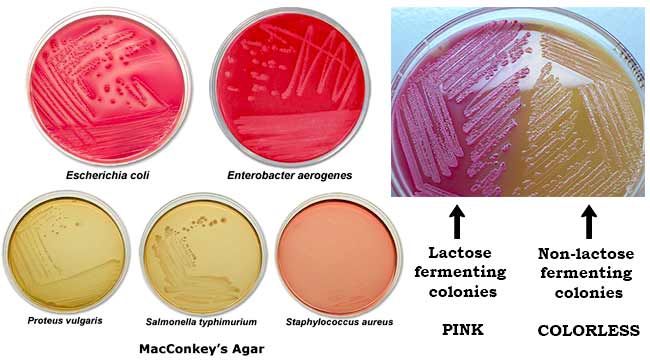
MacConkey agar (MAC) was the first solid differential media to be formulated which was developed at 20th century by Alfred Theodore MacConkey. MacConkey agar is a selective and differential media used for the isolation and differentiation of non-fastidious gram-negative rods, particularly members of the family Enterobacteriaceae and the genus Pseudomonas.
Composition of MacConkey Agar
| Ingredients | Amount |
| Peptone (Pancreatic digest of gelatin) | 17 gm |
| Proteose peptone (meat and casein) | 3 gm |
| Lactose monohydrate | 10 gm |
| Bile salts | 1.5 gm |
| Sodium chloride | 5 gm |
| Neutral red | 0.03 gm |
| Crystal Violet | 0.001 g |
| Agar | 13.5 gm |
| Distilled Water | Add to make 1 Liter |
Final pH 7.1 +/- 0.2 at 25 degrees C.
Principle of MacConkey Agar
MacConkey agar is used for the isolation of gram-negative enteric bacteria and the differentiation of lactose fermenting from lactose non-fermenting gram-negative bacteria. Pancreatic digest of gelatin and peptones (meat and casein) provide the essential nutrients, vitamins and nitrogenous factors required for growth of microorganisms. Lactose monohydrate is the fermentable source of carbohydrate. The selective action of this medium is attributed to crystal violet and bile salts, which are inhibitory to most species of gram-positive bacteria. Sodium chloride maintains the osmotic balance in the medium. Neutral red is a pH indicator that turns red at a pH below 6.8 and is colorless at any pH greater than 6.8. Agar is the solidifying agent.
Uses of MacConkey Agar
- MacConkey agar is used for the isolation of gram-negative enteric bacteria.
- It is used in the differentiation of lactose fermenting from lactose non-fermenting gram-negative bacteria.
- It is used for the isolation of coliforms and intestinal pathogens in water, dairy products and biological specimens.
Preparation of MacConkey Agar
- Suspend 49.53 grams of dehydrated medium in 1000 ml purified/distilled water.
- Heat to boiling to dissolve the medium completely.
- Sterilize by autoclaving at 15 lbs pressure (121°C) for 15 minutes.
- Cool to 45-50°C.
- Mix well before pouring into sterile Petri plates.
Result Interpretation on MacConkey Agar
Lactose fermenting strains grow as red or pink and may be surrounded by a zone of acid precipitated bile. The red colour is due to production of acid from lactose, absorption of neutral red and a subsequent colour change of the dye when the pH of medium falls below 6.8.
Lactose non-fermenting strains, such as Shigella and Salmonella are colourless and transparent and typically do not alter appearance of the medium. Yersinia enterocolitica may appear as small, non-lactose fermenting colonies after incubation at room temperature.
Colony Morphology on MacConkey Agar

Organism
|
Colour
|
Remarks
|
Escherichia coli
|
red/pink
|
non-mucoid
|
Aerobacter aerogenes
|
pink
|
mucoid
|
Enterococcus species
|
red
|
minute, round
|
Staphylococcus species
|
pale pink
|
opaque
|
Pseudomonas aeruginosa
|
green-brown
|
fluorescent growth
|
Limitations of MacConkey Agar
- The colonial characteristics described give presumptive identification only of the isolated organisms. It is necessary to subculture and carry out confirmation tests for final identification.
- Some strains may be encountered that grow poorly or fail to grow on this medium.
- Incubation of MacConkey Agar plates under increased CO2 has been reported to reduce growth and recovery of a number of strains of Gram-negative bacilli.
- Some strains of Proteus may swarm on this medium.
References
- Austin Community College, 5930 Middle Fiskville Rd., Austin, Texas
- ASM Microbe Library: MacConkey Agar Plates Protocols
- Thermo Fisher Scientific Inc., Dehydrated Culture Media: MacConkey Agar
- Acumedia Manufacturers: MacConkey Agar
- HiMedia Laboratories Pvt. Ltd, Technical data: MacConkey Agar
- Hardy Diagnostics: MacConkey Agar
- Science Prof Online (SPO): MacConkey Agar
- Bacteriological Analytical Manual, 8th Edition, Revision A, 1998.
- Collin County Community College District.
- Microbe Online
- Wikipedia




ليست هناك تعليقات:
إرسال تعليق
Due to the high number of spammy comments we have decided to initiate comment moderation so that we can maintain our quality standards and make good environment for our visitors. Please leave your comment